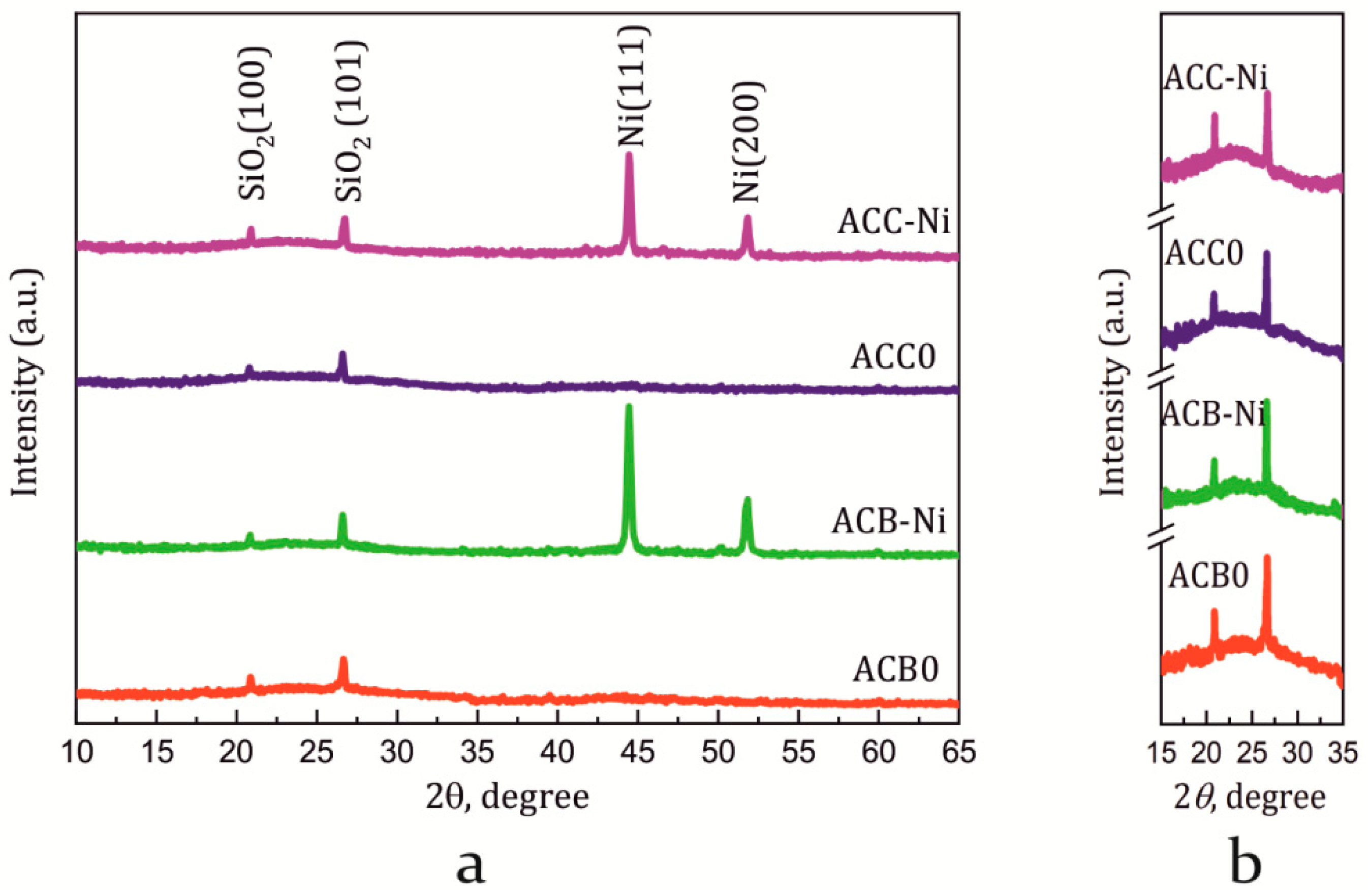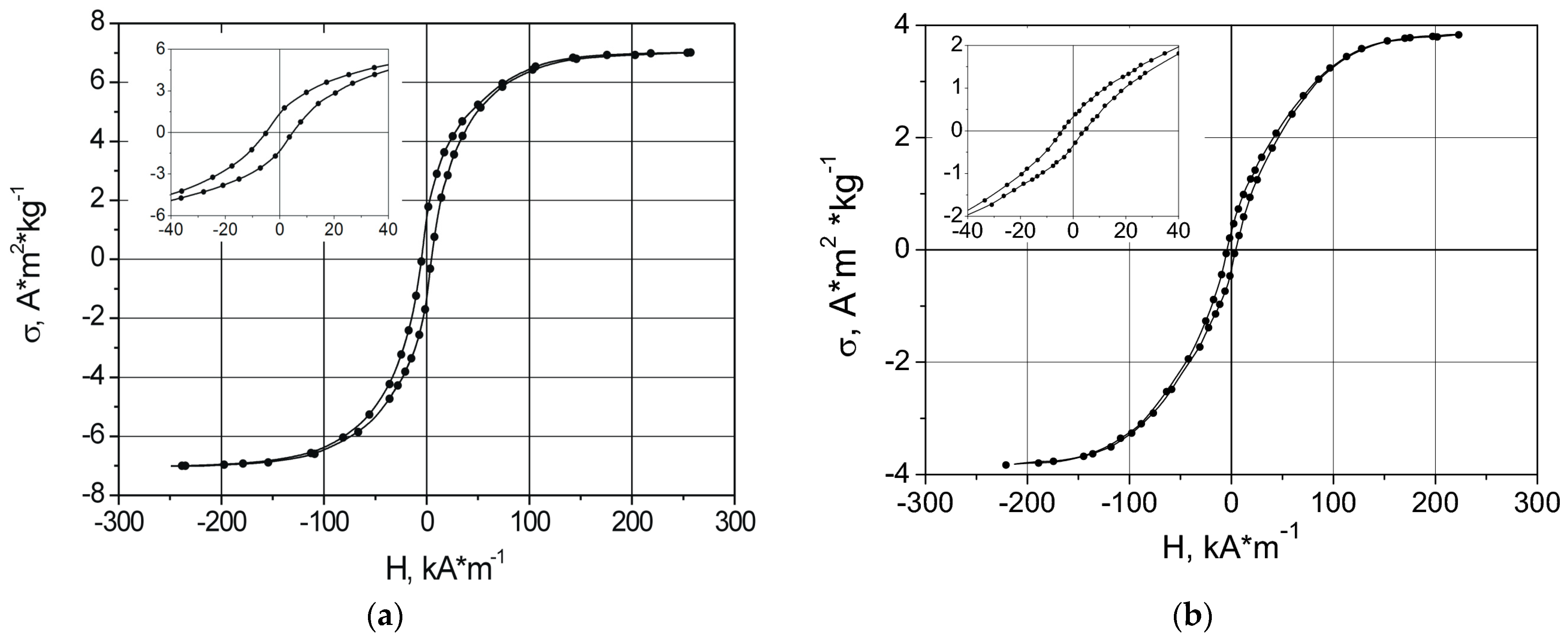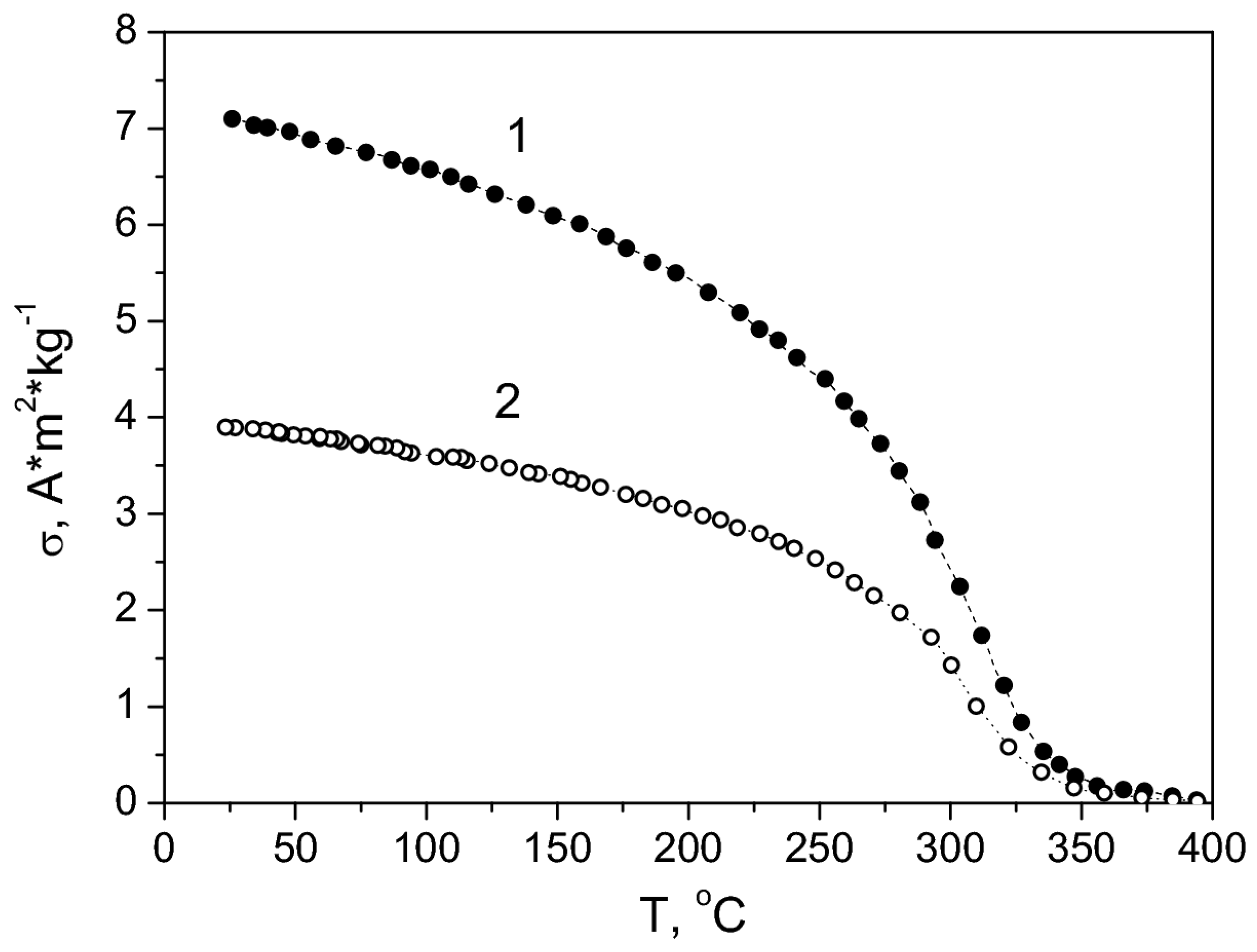Structural and Magnetic Properties of Ni/C Composites Synthesized from Beet Pulp and Corn Stems
Abstract
:1. Introduction
2. Experiments and Methods
2.1. Sample Preparation
2.2. Methods of Investigation
3. Results and Discussion
4. Conclusions
Author Contributions
Funding
Conflicts of Interest
References
- Jin, Y.; Berhrens, P.; Tukker, A.; Scherer, L. Water use of electricity technologies: A global meta-analysis. Renew. Sustain. Energy Rev. 2019, 115, 109391. [Google Scholar] [CrossRef]
- Gupta, A.D.; Pandey, P.; Feijoo, A.; Yaseen, Z.M.; Bokde, N.D. Smart Water Technology for Efficient Water Resource Management: A Review. Energies 2020, 13, 6268. [Google Scholar] [CrossRef]
- Nriagu, J.O. Global Metal Pollution: Poisoning the Biosphere? Environ. Sci. Policy Sustain. Dev. 1990, 32, 7–33. [Google Scholar] [CrossRef]
- Chen, L.; Sheng, H.L. Electrocoagulation of chemical mechanical polishing (CMP) wastewater from semiconductor fabrication. Chem. Eng. J. 2003, 95, 205–211. [Google Scholar] [CrossRef]
- Ding, Z.H.; Hu, X.; Wan, Y.S.; Wang, S.S.; Gao, B. Removal of lead, copper, cadmium, zinc, and nickel from aqueous solutions by alkali-modified biochar: Batch and column tests. J. Ind. Eng. Chem. 2016, 33, 239–245. [Google Scholar] [CrossRef] [Green Version]
- Huang, C.J.; Yang, B.M.; Chen, K.S.; Chang, C.C.; Kao, C.M. Application of membrane technology on semiconductor wastewater reclamation: A pilot-scale study. Desalination 2011, 278, 203–210. [Google Scholar] [CrossRef]
- Dehkhoda, A.M.; Ellis, N.; Gyenge, E. Electrosorption on activated biochar: Effect of thermo-chemical activation treatment on the electric double layer capacitance. J. Appl. Electrochem. 2014, 44, 141–157. [Google Scholar] [CrossRef]
- Bolisetty, S.; Peydayesh, M.; Mezzenga, R. Sustainable technologies for water purification from heavy metals: Review and analysis. Chem. Soc. Rev. 2019, 48, 463–487. [Google Scholar] [CrossRef]
- Safarik, I.; Horska, K.; Pospiskova, K.; Safarikova, M. Magnetically Responsive Activated Carbons for Bio- and Environmental Applications. Int. Rev. Chem. Eng. 2012, 4, 346–352. [Google Scholar]
- Ni, Y.; Jin, L.; Zhang, L.; Hong, J. Honeycomb-like Ni@C composite nanostructures: Synthesis, properties and applications in the detection of glucose and the removal of heavy-metal ions. J. Mater. Chem. 2010, 20, 6430–6436. [Google Scholar] [CrossRef]
- Gymes-Pastora, J.; Brindas, E.; Ortiz, I. Recent progress and future challenges on the use of high performance magnetic nano-adsorbents in environmental applications. Chem. Eng. J. 2014, 256, 187–204. [Google Scholar] [CrossRef]
- Speltini, A.; Sturini, M.; Maraschi, F.; Profumo, A. Recent trends in the application of the newest carbonaceous materials for magnetic solid-phase extraction of environmental pollutants. Trends Environ. Anal. Chem. 2016, 10, 11–23. [Google Scholar] [CrossRef]
- Yu, M.; Liu, Y.; Sellmyer, D.J. Nanostructure and magnetic properties of composite Co Pt: C films for extremely high-density recording. J. Appl. Phys. 2000, 87, 6959–6961. [Google Scholar] [CrossRef]
- Wang, Y.; Wang, J.; Fan, G.; Li, F. Synthesis of novel Ni/C catalyst derived from a composite precursor for hydrodechlorination. Catal. Commun. 2012, 19, 56–60. [Google Scholar] [CrossRef]
- Lyu, S.; Liu, C.; Wang, G.; Zhang, Y.; Li, J.; Wang, L. Structural evolution of carbon in an Fe@C catalyst during the Fischer-Tropsch synthesis reaction. Catal. Sci. Technol. 2019, 9, 1013–1020. [Google Scholar] [CrossRef]
- Aluha, J.; Abatzoglou, N. Gold-promoted plasma-synthesized Ni-Co-Fe/C catalyst for Fischer-Tropsch synthesis. Gold Bull. 2017, 50, 147–162. [Google Scholar] [CrossRef]
- Podsiadły, M.; Narkiewicz, U.; Arabczyk, W. Preparation of carbon-encapsulated cobalt nanoparticles by catalytic ethane decomposition. Mater. Sci. Poland. 2008, 26, 357–364. [Google Scholar]
- Yao, T.; Cui, T.; Wu, J. Preparation of acid-resistant core/shell Fe3O4/C materials and their use as catalyst supports. Carbon 2012, 50, 2287–2295. [Google Scholar] [CrossRef]
- Xia, W.; Zou, R.Q.; An, L.; Xia, D.G.; Guo, S.J. A metal-organic framework route to in situ encapsulation of Co@Co3O4@C core@bishell nanoparticles into a highly ordered porous carbon matrix for oxygen reduction. Energy Environ. Sci. 2015, 8, 568–576. [Google Scholar] [CrossRef]
- Yan, P.; Guo, W.; Liang, Z.; Meng, W.; Yin, Z.; Li, S.; Li, M.; Zhang, M.; Yan, J.; Xiao, D.; et al. Highly efficient K-Fe/C catalysts derived from metal-organic frameworks towards ammonia synthesis. Nano Res. 2019, 12, 2341–2347. [Google Scholar] [CrossRef]
- Ziogas, P.; Bourlinos, A.B.; Tucek, J.; Malina, O.; Douvalis, A.P. Novel Magnetic Nanohybrids: From Iron Oxide to Iron Carbide Nanoparticles Grown on Nanodiamonds. Magnetochemistry 2020, 6, 73. [Google Scholar] [CrossRef]
- Available online: https://www.statista.com/statistics/254292/global-corn-production-by-country (accessed on 20 February 2021).
- Martínez-Casillas, D.C.; Mascorro-Gutiérrez, I.; Betancourt-Mendiola, M.L.; Palestino, G.; Quiroga-González, E.; Pascoe-Sussoni, J.E.; Guillén-López, A.; Muñiz, J.; Cuentas-Gallegos, A.K. Residue of Corncob Gasification as Electrode of Supercapacitors: An Experimental and Theoretical Study. Waste Biomass Valor 2020. [Google Scholar] [CrossRef]
- Cao, Q.; Xie, K.; Lv, Y.; Bao, W. Process effects on activated carbon with large specific surface area from corn cob. Bioresour. Technol. 2006, 97, 110–115. [Google Scholar] [CrossRef] [PubMed]
- Mishra, S.; Yadav, S.S.; Rawat, S.; Singh, J.; Koduru, J.R. Corn husk derived magnetized activated carbon for the removal of phenol and para-nitrophenol from aqueous solution: Interaction mechanism, insights on adsorbent characteristics, and isothermal, kinetic and thermodynamic properties. J. Environ. Manag. 2019, 246, 362–373. [Google Scholar] [CrossRef] [PubMed]
- Bordun, I.; Ptashnyk, V.; Sadova, M.; Chapovska, R. Utilization of sugar beet pulp by getting activated carbon. Environ. Probl. 2017, 2, 29–32. Available online: http://science.lpnu.ua/sites/default/files/journal-paper/2017/oct/6412/fulltext.pdf (accessed on 20 February 2021).
- Soloviy, C.; Malovanyy, M.; Bordun, I.; Ivashchyshyn, F.; Borysiuk, A.; Kulyk, Y. Structural, magnetic and adsorption characteristics of magnetically susceptible carbon sorbents based on natural raw materials. J. Water Land Dev. 2020, 47, 160–168. [Google Scholar] [CrossRef]
- Bordun, I.; Sadova, M.; Gorodnia, T. Determination of the specific surface area of activated carbon materials on the basis of methylene blue adsorbtion. Slovak Int. Sci. J. 2017, 11, 17–21. (In Ukrainian) [Google Scholar]
- Duriagina, Z.A.; Goliaka, R.L.; Borysiuk, A.K. The Automated Wide-Range Magnetometer for the Magnetic Phase Analysis of Alloys: Development and Application. Uspekhi Fiziki Metallov. 2013, 14, 33–66. (In Ukrainian) [Google Scholar] [CrossRef] [Green Version]
- Galaburda, M.V.; Bogatyrov, V.M.; Tomaszewski, W.; Oranska, O.I.; Borysenko, M.V.; Skubiszewska-Zięba, J.; Gun’ko, V.M. Adsorption/desorption of explosives on Ni-, Co-, and NiCo-carbon composites: Application in solid phase extraction. Colloids Surf. A 2017, 529, 950–958. [Google Scholar] [CrossRef]
- Marinoni, N.; Broekmans, M.A.T.M. Microstructure of selected aggregate quartz by XRD, and a critical review of the crystallinity index. Cem. Concr. Res. 2013, 54, 215–225. [Google Scholar] [CrossRef]
- Jiang, X.; Chen, J.; Wei, M.; Li, F.; Ban, B.; Li, J. Effect of impurity content difference between quartz particles on flotation behavior and its mechanism. Powder Technol. 2020, 375, 504–512. [Google Scholar] [CrossRef]
- Bocullo, V.; Vitola, L.; Vaiciukyniene, D.; Kantautas, A.; Bajare, D. The influence of the SiO2/Na2O ratio on the low calcium alkali activated binder based on fly ash. Mater. Chem. Phys. 2021, 258, 123846. [Google Scholar] [CrossRef]
- Adewunmi, A.A.; Amao, A.O.; Kamal, M.S.; Solling, T.I. Demulsification and breaking mechanism of variable quartz concentrates obtained from sand. J. Pet. Sci. Eng. 2020, 192, 107263. [Google Scholar] [CrossRef]
- Li, H.; He, Y.; Yang, Q.; Wang, J.; Yan, S.; Chen, C.; Chen, J. Urchin-like Ni@N-doped carbon composites with Ni nanoparticles encapsulated in N-doped carbon nantubes as high-efficient electrocatalyst for oxygen evolution reaction. J. Solid State Chem. 2019, 278, 120843. [Google Scholar] [CrossRef]
- Raimundo, R.A.; Silva, V.D.; Simões, T.A.; Medeiros, E.S.; Macedo, D.A.; Morales, M.A. Ni/NiO-carbon composite fibers prepared by solution blow spinning: Structure and magnetic properties. Ceram. Int. 2020, 46, 18933–18939. [Google Scholar] [CrossRef]
- Ying, T.; Zhang, J.; Liu, X.; Yu, J.; Yu, J.; Zhang, X. Corncob-derived hierarchical porous carbon/Ni composites for microwave absorbing application. J. Alloys Compd. 2020, 849, 156662. [Google Scholar] [CrossRef]
- Ren, H.; Shu, X.; Liu, Z.; Zhou, J.; Ma, J.; Liu, Y.; Kong, L.B.; Min, F.; Shi, X.; Han, J.; et al. In-situ synthesis of layered porous coal-derived carbon/Ni magnetic composites with promising microwave absorption performance. J. Magn. Magn. Mater. 2020, 513, 167231. [Google Scholar] [CrossRef]
- Xiao, N.; Zhang, X.; Liu, C.; Wang, Y.; Li, H.; Qiu, J. Coal-based carbon anodes for highperformance potassium-ion batteries. Carbon 2019, 147, 574–581. [Google Scholar] [CrossRef]
- Zhu, X.; Qian, F.; Liu, Y.; Matera, D.; Wu, G.; Zhang, S.; Chen, J. Controllable synthesis of magnetic carbon composites with high porosity and strong acid resistance from hydrochar for efficient removal of organic pollutants: An overlooked influence. Carbon 2016, 99, 338–347. [Google Scholar] [CrossRef]
- He, X.; Zhong, W.; Au, C.-T.; Du, Y. Size dependence of the magnetic properties of Ni nanoparticles prepared by thermal decomposition method. Nanoscale Res. Lett. 2013, 8, 446. [Google Scholar] [CrossRef] [PubMed] [Green Version]
- Krishnan, K.M.; Pakhomov, A.B.; Bao, Y.; Blomqvist, P.; Chun, Y.; Gonzales, M.; Roberts, B.K. Nanomagnetism and spin electronics: Materials, microstructure and novel properties. J. Mater. Sci. 2006, 41, 793–815. [Google Scholar] [CrossRef]
- Coey, J.M.D. Magnetism and Magnetic Materials; Cambridge University Press: Cambridge, UK, 2010; p. 625. [Google Scholar] [CrossRef] [Green Version]
- Du, Y.; Xu, M.; Wu, J.; Shi, Y.; Lu, H.; Xue, R. Magnetic properties of ultrafine nickel particles. J. Appl. Phys. 1991, 70, 5903–5905. [Google Scholar] [CrossRef]
- Yao, Y.D.; Chen, Y.Y.; Hsu, C.M.; Lin, H.M.; Tung, C.Y.; Tai, M.F.; Suo, C.T. Thermal and magnetic studies of nanocrystalline Ni. Nanostruct. Mat. 1995, 6, 933–936. [Google Scholar] [CrossRef]





| Sample | σs, A·m2/kg | Hc, kA/m | Ni, wt.% |
|---|---|---|---|
| ACB-Ni | 7.1 | 5 | 13 |
| ACC-Ni | 3.9 | 4 | 7.2 |
Publisher’s Note: MDPI stays neutral with regard to jurisdictional claims in published maps and institutional affiliations. |
© 2021 by the authors. Licensee MDPI, Basel, Switzerland. This article is an open access article distributed under the terms and conditions of the Creative Commons Attribution (CC BY) license (http://creativecommons.org/licenses/by/4.0/).
Share and Cite
Bordun, I.; Pidluzhna, A.; Ivashchyshyn, F.; Borysiuk, A.; Całus, D.; Chwastek, K. Structural and Magnetic Properties of Ni/C Composites Synthesized from Beet Pulp and Corn Stems. Magnetochemistry 2021, 7, 31. https://doi.org/10.3390/magnetochemistry7030031
Bordun I, Pidluzhna A, Ivashchyshyn F, Borysiuk A, Całus D, Chwastek K. Structural and Magnetic Properties of Ni/C Composites Synthesized from Beet Pulp and Corn Stems. Magnetochemistry. 2021; 7(3):31. https://doi.org/10.3390/magnetochemistry7030031
Chicago/Turabian StyleBordun, Ihor, Anna Pidluzhna, Fedir Ivashchyshyn, Anatoliy Borysiuk, Dariusz Całus, and Krzysztof Chwastek. 2021. "Structural and Magnetic Properties of Ni/C Composites Synthesized from Beet Pulp and Corn Stems" Magnetochemistry 7, no. 3: 31. https://doi.org/10.3390/magnetochemistry7030031
APA StyleBordun, I., Pidluzhna, A., Ivashchyshyn, F., Borysiuk, A., Całus, D., & Chwastek, K. (2021). Structural and Magnetic Properties of Ni/C Composites Synthesized from Beet Pulp and Corn Stems. Magnetochemistry, 7(3), 31. https://doi.org/10.3390/magnetochemistry7030031








